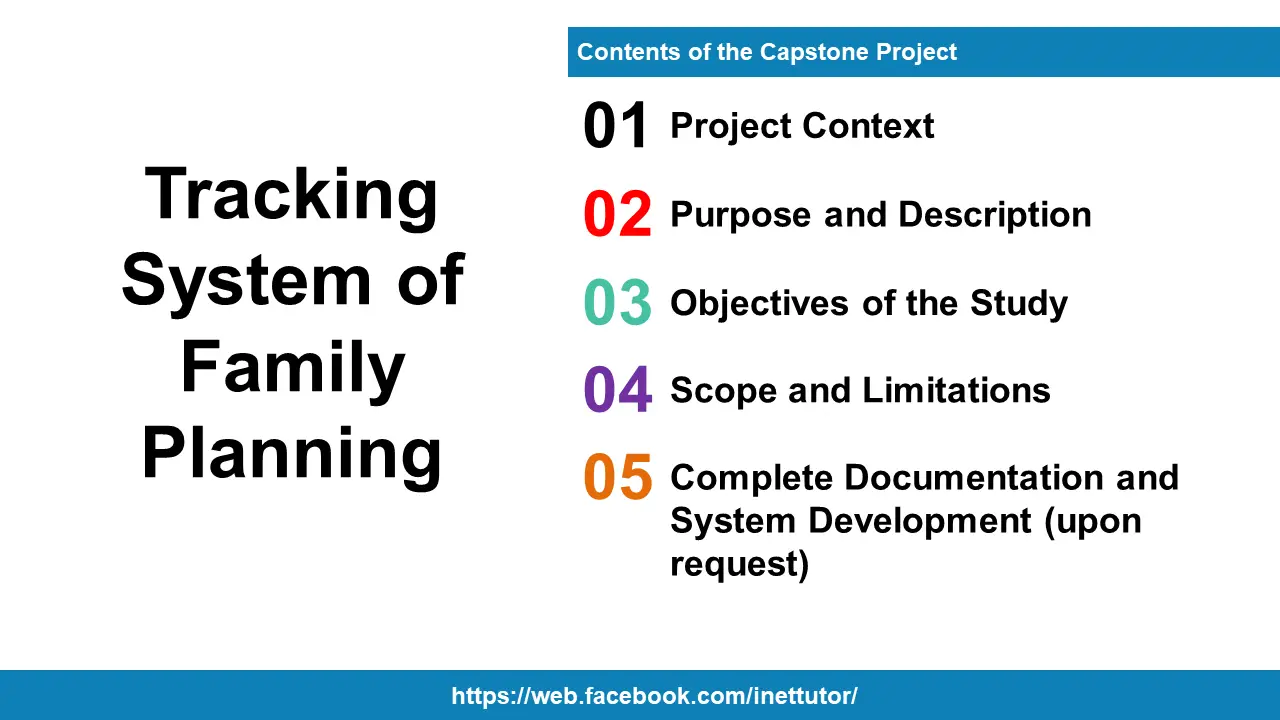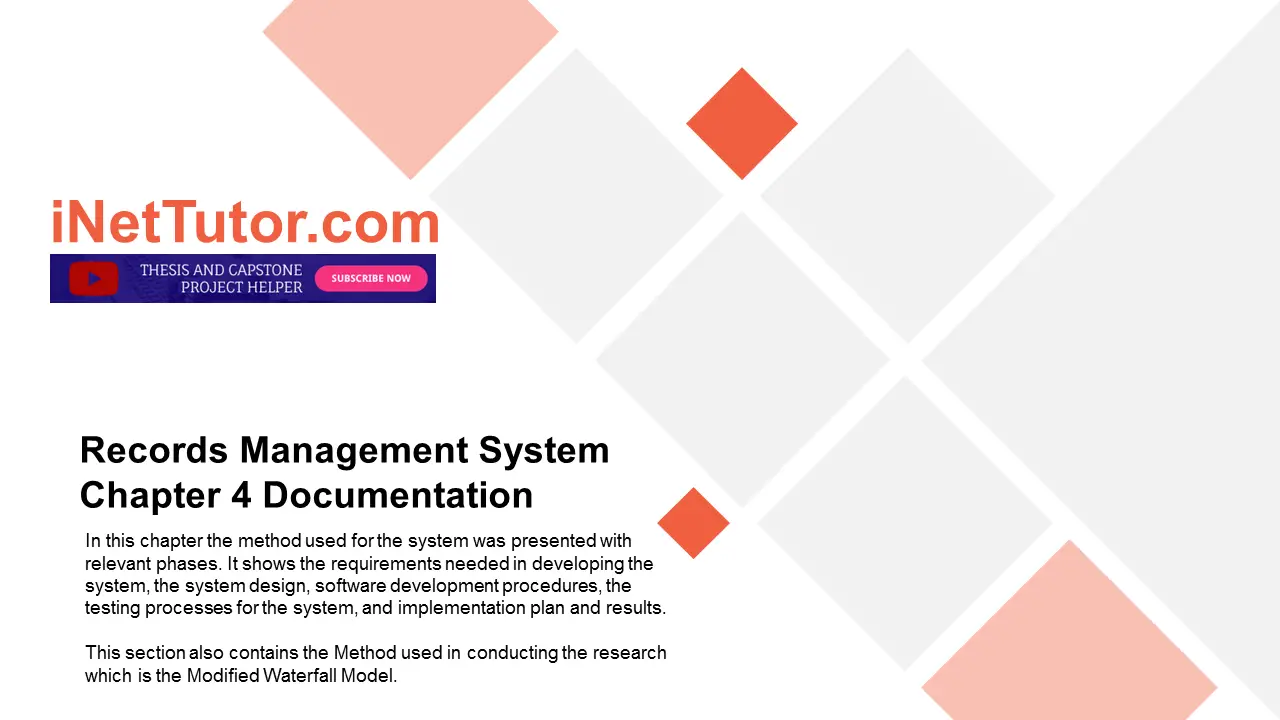Tracking System of Family Planning
Introduction
Table of Contents
The use of technology in our modern world changed people daily activities, and a lot more. Technology can refer to material objects of use to humanity such as computers and system software and such technologies are become widely used by most institutions today to give systematized services to their clientele. It gives more convenience to the user and contributes a lot to the speed and accuracy of every transaction; reduces time and effort. Computers are used for the storage and management of data; they can serve as huge knowledge bases and can be harnessed for all sorts of transactions due to their processing power and storage capacities. As computers are a daily utility, they have gained immense importance in day-to-day life.
Barangay Name is a Barangay in Name of the City with about Five Thousand Four Hundred Thirty-Eight (5,438) total population. They obtained records of patients in the locality which help them generate analytical reports. However, some of their records are rumbled in their record books which are not typical storage of data in terms of security. In this process of recording, the Barangay Secretary found it hard to retrieve related information in case needed.
The aim of this study is to provide a paperless Patient Monitoring and Tracking System of Family Planning in the Community. It also aims to provide a system that will help the end-users give a better service in a systematic way by manipulating all the information gathered from the community it is serving. This is to help the beneficiaries of the project to continually do their mission, vision, and goals through providing services fully to the residents and community of the target community.

Project Context
Nowadays we cannot deny that most of the transactions are done through the help of technology. Technology helps you in many ways. It makes information storage easier and faster thus it can save a lot of time. The proposed system will manage the information that will be saved in the specific database. Persons involved are the Office Personnel, by means of conducting general survey and interview. This system will help this year and the oncoming future years in the city for making their system computerized and easy to use for everyone.
The implementation of the “Patient Monitoring and Tracking System of Family Planning in the Community” provides a quicker and more systematic way to record the information of patients and as well as tracking and providing support through the notification features of the system. It also provides reliable and secured personal information records.
The information system for patient monitoring has the following features:
Centralized Profiling Management – the information of the patient and family will be encoded in every barangay but the records are consolidated in the central server.
Notification and Communication Module – all activities related to health and family planning such as meetings, gatherings, and other important messages are stored, channeled, and disseminated through the use of this platform.
Services Module – this module stores the services provided/rendered by the barangay, city or any other individuals or groups to the patient beneficiary.
Report Generation Module – this module can produce hardcopy reports on the list of patients per and individual personal database of the patients.
Objectives
General Objective
The purpose of the study is to design, develop and implement a Patient Monitoring and Tracking System of Family Planning in the Community that would replace or serve as an alternative to the currently existing process which is done manually.
Specific Objectives
Specifically, the project aims to:
- Input patient demographic profile electronically
- Provide notification and information dissemination to the patient related to health and family planning.
- Organize the records in an effective and efficient manner using a database system.
- Provide a database backup feature for the entire record.
Scope
The project is only intended for the records management of patients in the community and not the entire population of the area. Health-related records are the primary target of this study.
Significance
The result of the study is important to the following:
Patient/Resident. This study is very important to the patient/resident of the community for they will be informed easily of the activities, meetings, and other services that they can avail.
Barangay Personnel. This study has benefited the barangay personnel in terms of fast monitoring of patient records in their respective area assigned.
Future Researcher. The study was benefited the future researcher for they have an overview of the system and have improvements of the study later on.
SDLC
This phase presents the system design and methodology which includes the requirements, analysis, and documentation on the different stages such as data analysis, quick design, system design, prototype cycle, testing, and implementation.
Figure 1.0 shows the System Development Life Cycle (SDLC). These methodologies help to design a framework for planning, analysis, implementation, testing, monitoring and finally delivering a quality product to end-users (training-specialists.com).
Rapid Application Development Model
Figure 2.0 Rapid Application Development Model (RAD) for Patient Monitoring and Tracking System of Family Planning in the Community
Figure 2.0 shows the Prototype Model used by the researcher for the development of the system (webdev-il.blogspot.com).
Analysis and Quick Design
During Analysis and Quick Design phase, the researchers did an interview with the Barangay Secretary, Barangay Nutrition Scholar, and Barangay Health Worker. After the conduct of data gathering, the researchers made an initial design for the proposed system based on the end-users requirements.
Data Analysis
The researchers processed and analyzed the gathered data. The result of the analysis will benefit the developed system to determine the solutions needed by the respondents.
System Design
In this phase, the developer started to develop the proposed system including the actual design and layout.
Prototype Cycle
This phase includes three stages, the building demonstration, and refinement. The researchers will build a prototype. After building the prototype, the researcher will demonstrate to the client the different functions, features, and how the system works. The last phase is refinement, the researcher will refine the system, including the flow, needs or wants, and functions based on their requirements.
- Testing
In this phase, the system will be brought for testing using the following methods.
Testing involves white box testing and black-box testing.
- White box testing. Is a software testing method in which the internal structure/ design/ implementation of the item being tested is known to the tester. White boxes are the IT Experts and developers who know how to test the system.
- Black Box Testing. Is a software testing method in which the internal structure/ design/ implementation of the item being tested is NOT known to the tester. After the above testing, results and recommendations will be recorded to further improve the system.
Implementation
This phase will discuss the implementation of the proposed system if the recommendation and wants of respondents were met.
You may visit our Facebook page for more information, inquiries, and comments.
Hire our team to do the project.


